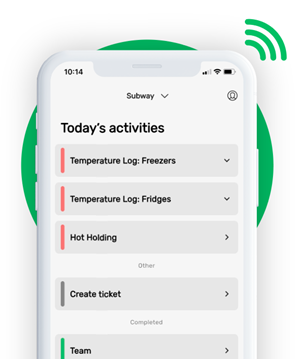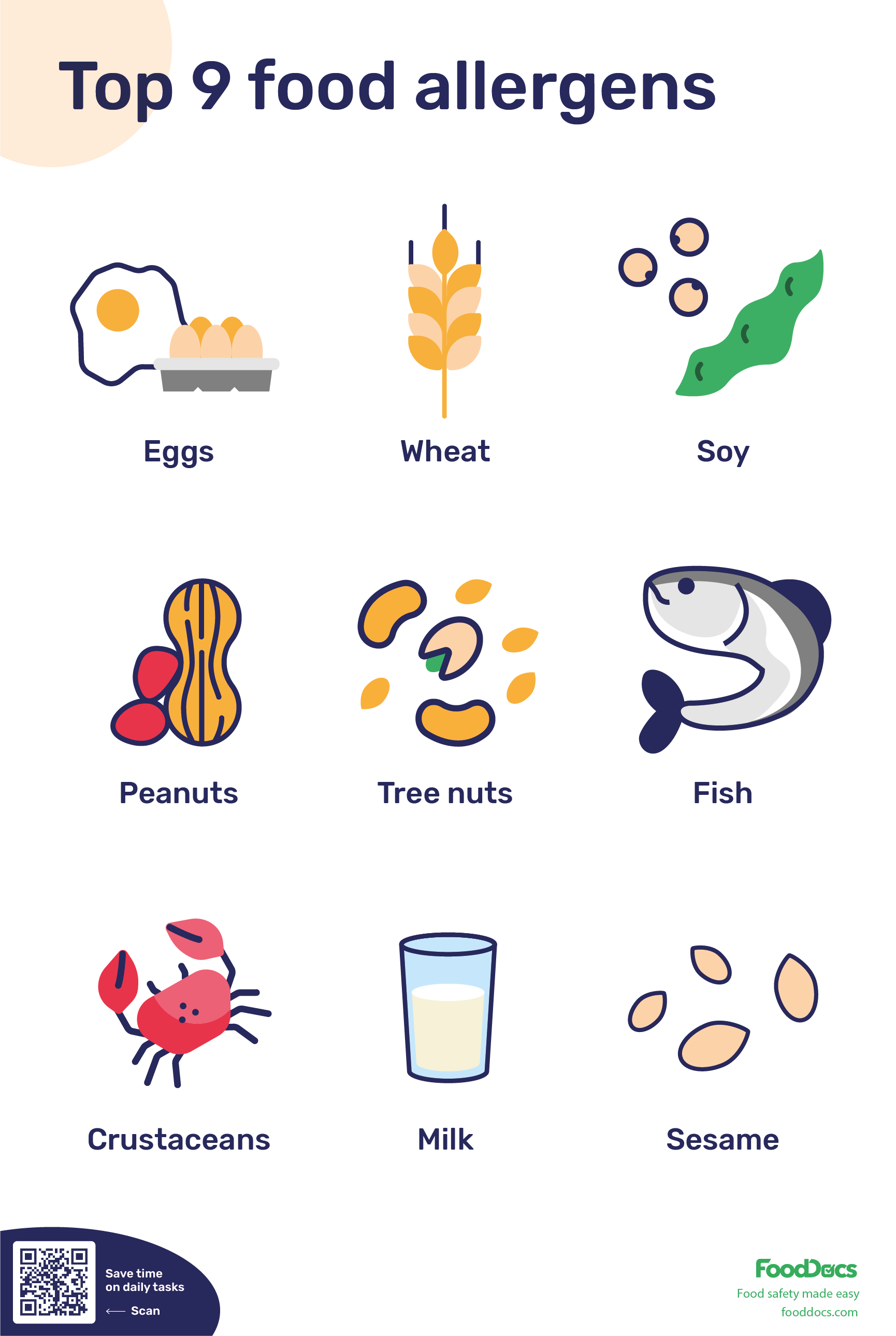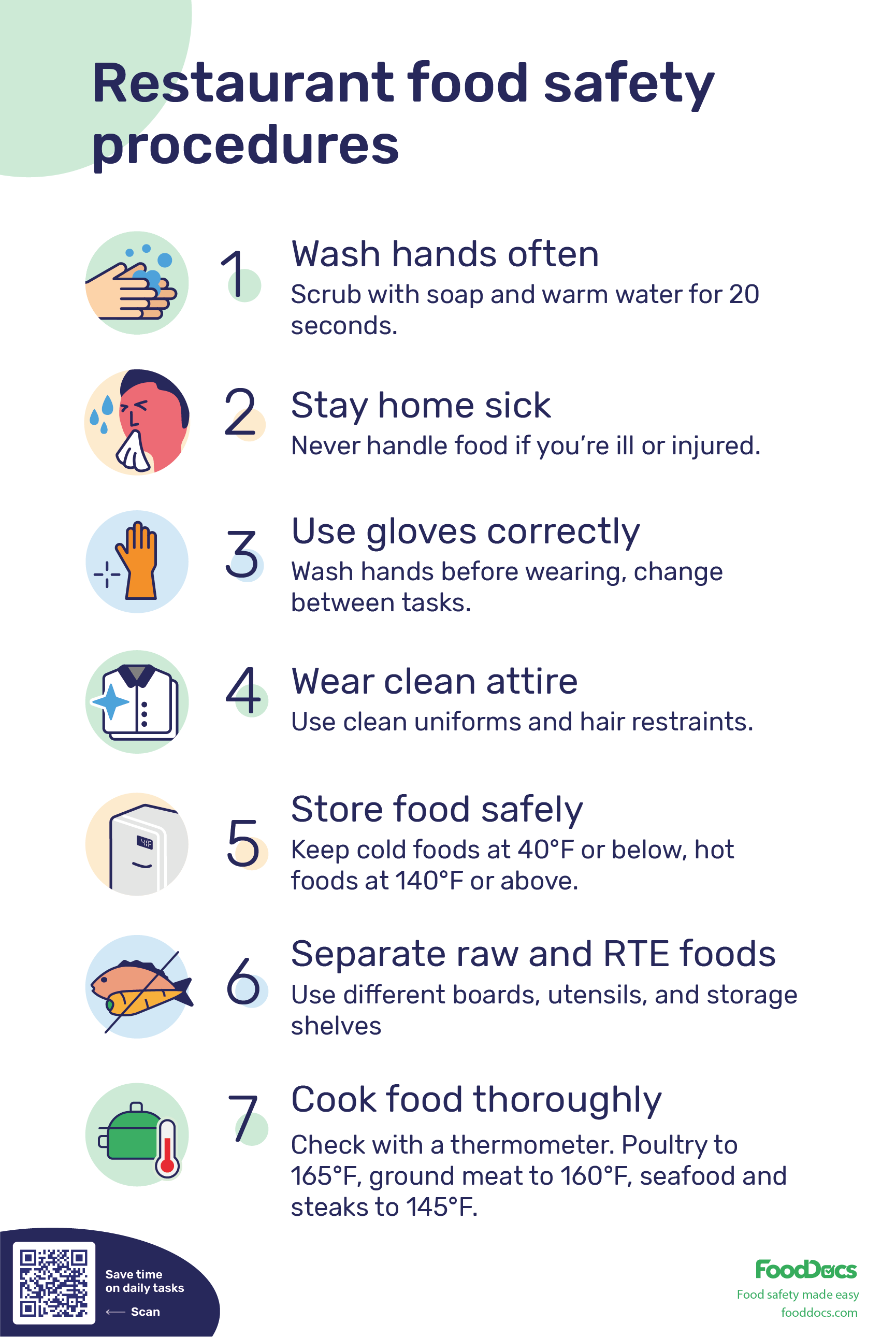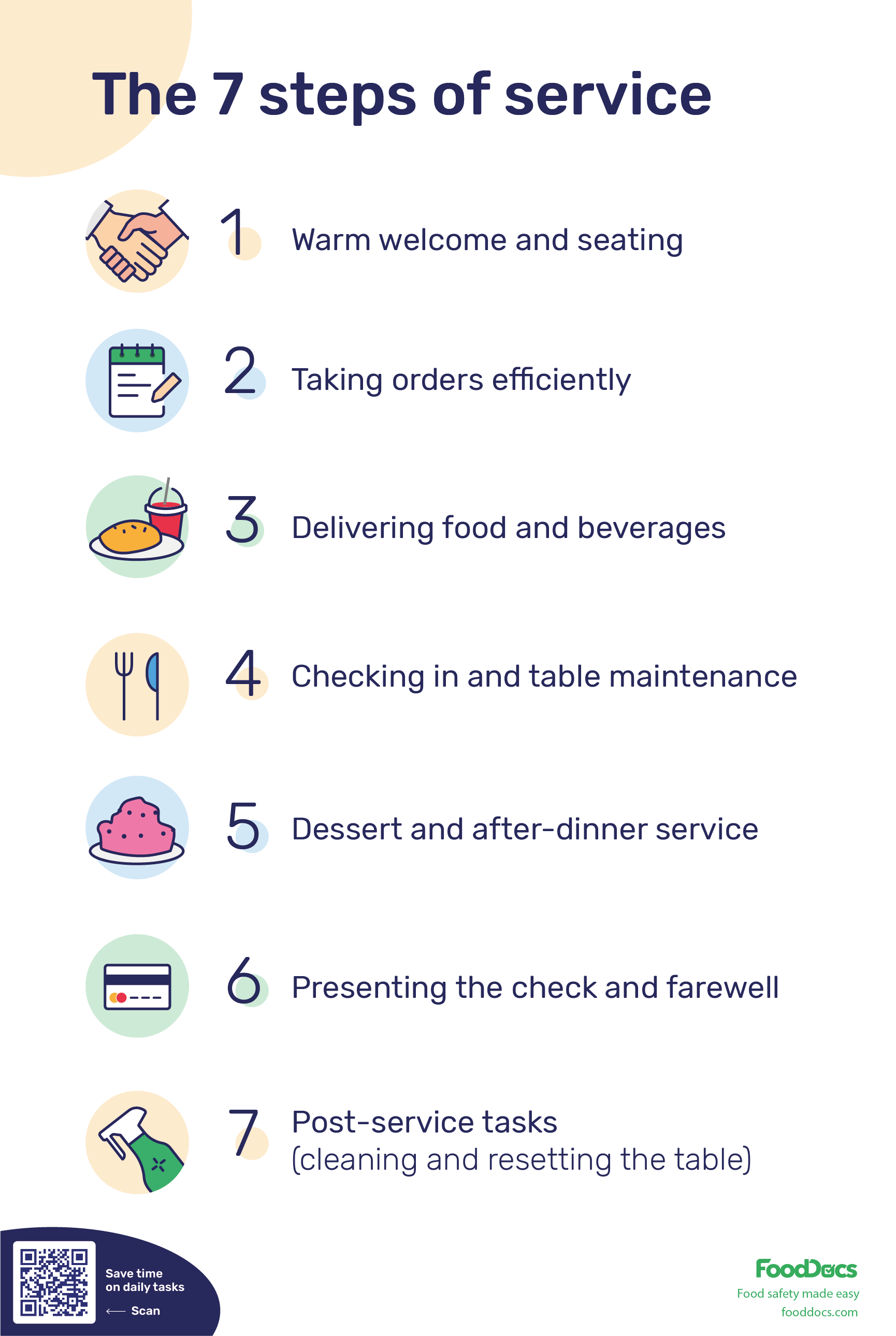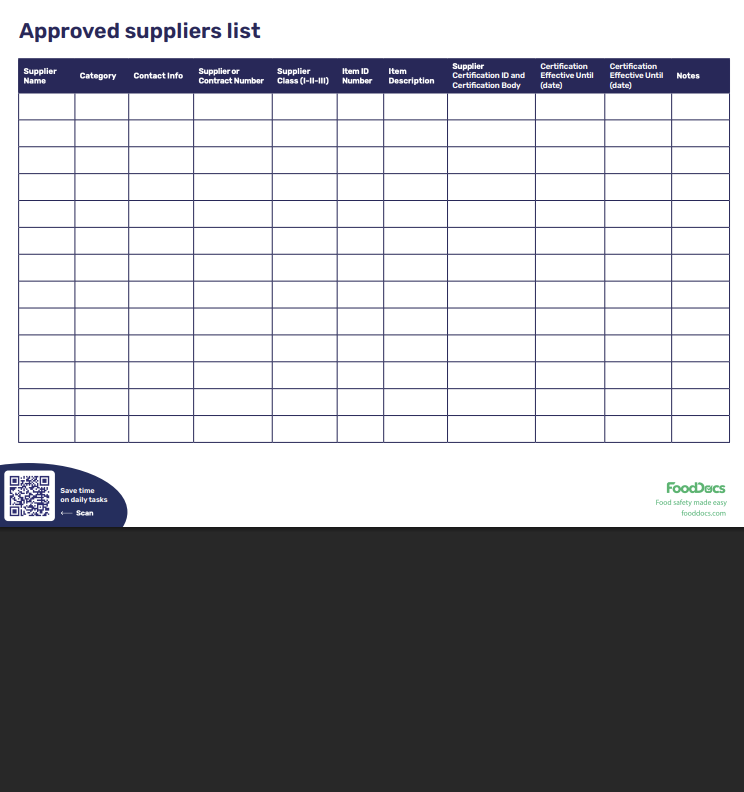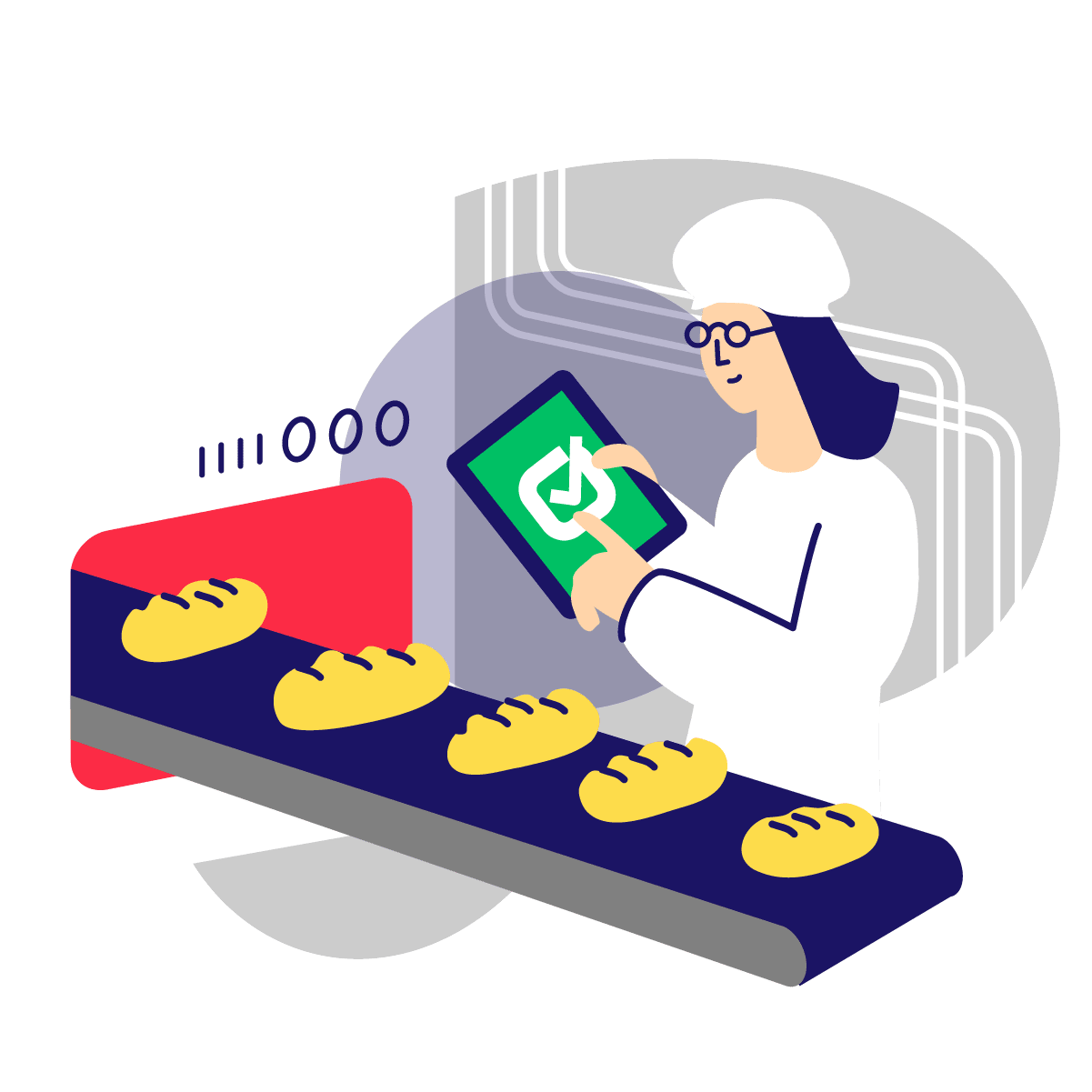A Complete Guide to Restaurant Manager Responsibilities (and What Makes a Great One)
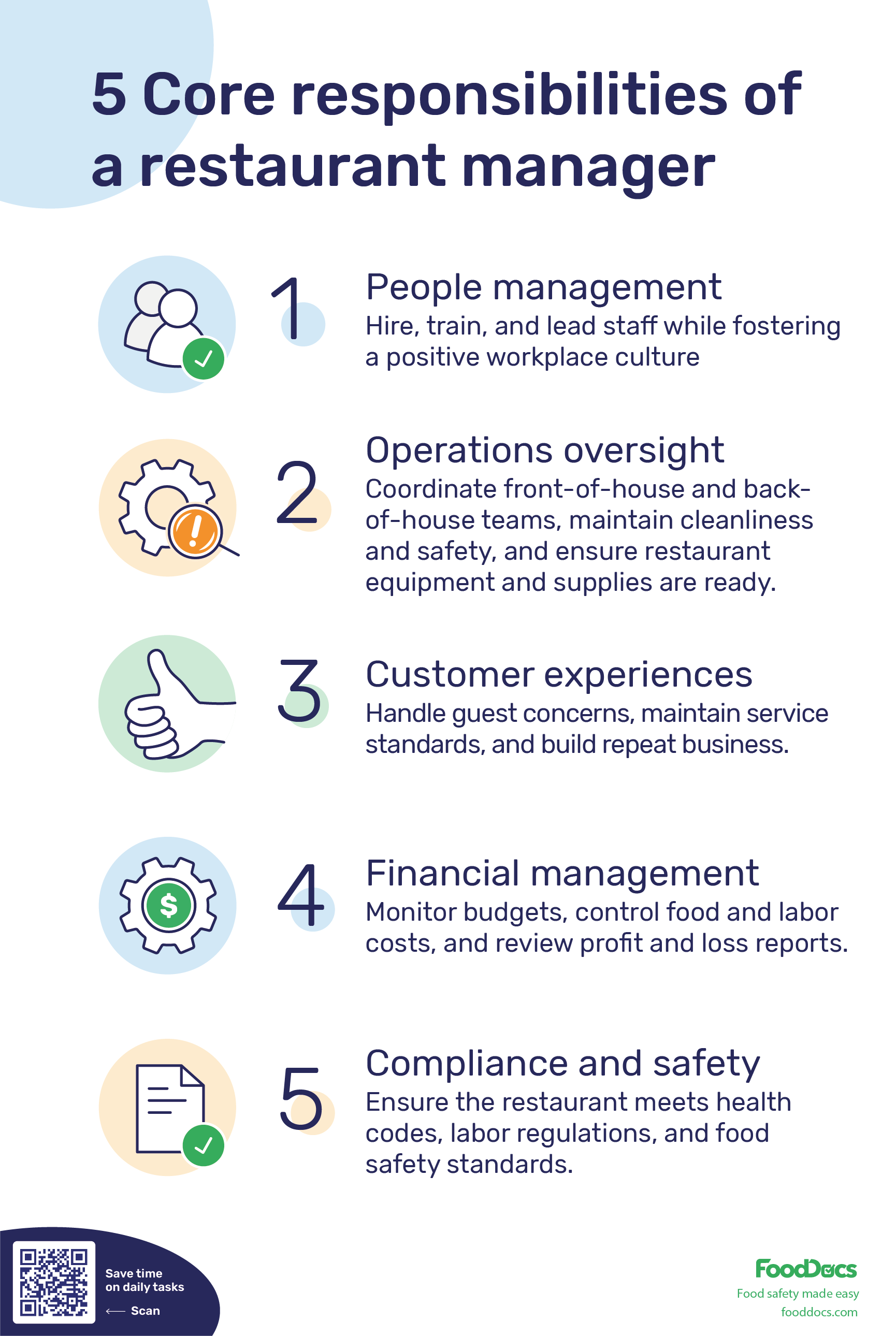



This is how our Digital Food Safety platform saves 20% of your time on daily tasks:
- Get upcoming task notifications
- Add data into the app
- Check the status of tasks in real-time

When food safety was still handled on paper, I typically spent a couple of hours per day getting the papers and going around checking or completing tasks… Now I can sit down and it's just all there in one place. It takes me 5-10 minutes.
Ruth B.
Store Manager
A restaurant manager ensures the business runs efficiently and profitably while leading a team of staff. They oversee all aspects of daily operations, including food safety and quality compliance, customer service, staffing schedules, inventory management, marketing, and other restaurant management duties, ensuring that high standards are maintained in each area.
Succeeding in this role requires excellent multitasking, organizational, and interpersonal skills, as managers must handle both strategic planning and hands-on problem-solving every day.
With so much to keep track of, being comfortable with and confident in digital solutions (e.g., food safety management software) that save time, simplify compliance, and contribute to growing the bottom line is a great skill to hone.
Key takeaways
-
A restaurant manager is ultimately responsible for all aspects of a restaurant, from staff leadership to finances, guest experience, and compliance.
-
The role of a restaurant manager often overlaps with a general manager, but managers focus on daily operations while GMs handle broader strategy.
-
Breaking duties into daily, weekly, and monthly routines helps managers stay consistent with operations, finances, training, and compliance.
-
Assistant managers act as second-in-command, handling scheduling, staff support, and leading when the manager is away.
-
Food safety and compliance are core responsibilities that require training staff and monitoring safety standards (and are made easy by software such as FoodDocs).
-
Strong managers lead by example, motivating staff with recognition, clear standards, and accountability.
-
Handling customer complaints well (e.g., listening, apologizing, acting quickly, and following up) can turn an unhappy guest into a loyal customer.
-
Modern managers must oversee restaurant technology, ensuring POS, scheduling, and ordering systems work smoothly.
-
Building strong vendor relationships and keeping backup suppliers maintains consistency and controls costs.
-
Crisis preparation for things such as equipment failure, inspections, or emergencies is vital for protecting both guests and the business.
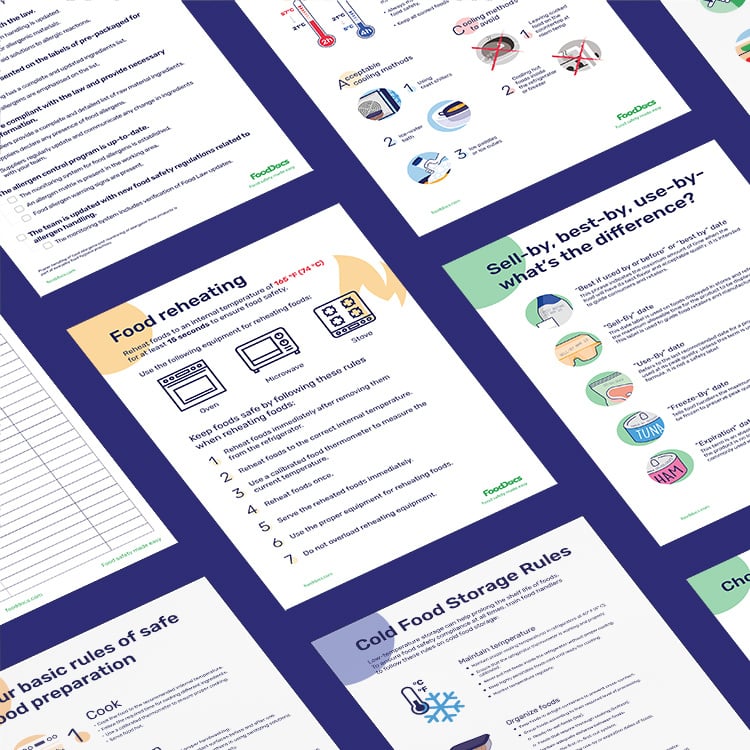
Get our most popular restaurant management resources
What are the core responsibilities of a restaurant manager?
A restaurant manager is responsible for overseeing all operations of a restaurant to ensure smooth service, satisfied customers, and financial success. Core responsibilities fall into five main areas:
- People management: Hiring, training, and leading staff while fostering a positive workplace culture.
- Operations oversight: Coordinating front-of-house and back-of-house teams, maintaining cleanliness and safety, and ensuring restaurant equipment and supplies are ready.
- Customer experience: Handling guest concerns, maintaining service standards, and building repeat business.
- Financial management: Monitoring budgets, controlling food and labor costs, and reviewing profit and loss reports.
- Compliance and safety: Ensuring the restaurant meets health codes, labor regulations, and food safety standards.

What skills and experience make a strong restaurant manager?
You don’t need a degree to lead well. What matters more is hands-on restaurant experience, strong soft skills, and comfort with operations and finance.
According to the Bureau of Labor Statistics, many food service managers start as cooks, servers, or supervisors. Some employers prefer postsecondary education for upscale venues, but it's experience that gets most candidates in the door.
Here are key skills that restaurant hiring teams often cite as essentials:
- Interpersonal communication
- Customer service
- Organization
- Multitasking
- Problem solving
- Business acumen
- Attention to detail

Staying calm under pressure, adapting to unexpected issues, and leading staff through busy shifts are soft skills that often set good managers apart.
Familiarity with food safety management systems, POS systems, scheduling systems, inventory control, and basic financial reporting helps you manage costs and make data-informed decisions.
Certifications like ServSafe or similar food safety credentials are very helpful, especially for compliance and inspections.
What are the daily duties of a restaurant manager?
On a day-to-day basis, a restaurant manager is responsible for a wide range of operational tasks to keep the restaurant running smoothly. Key daily duties include:
Opening procedures
Verify that the restaurant is ready for the day. This involves checking inventory levels (e.g., food, drinks, supplies) and confirming deliveries, inspecting overall cleanliness (e.g., kitchen, dining areas, restrooms) and sanitation, testing equipment (e.g., ovens, fryers, POS systems) for proper function, and reviewing the day’s menu or any special promotions.
Managers will also hold a five-minute staff meeting or briefing before service to communicate updated allergen information, daily specials, reservations, large parties, or any other important instructions for that shift.
Supervising service
Throughout the shift, the manager monitors customer satisfaction and the flow of service. They regularly check on guests to ensure a great dining experience, monitor the quality and safety of food as it comes out, and address any complaints or issues promptly.
Managers oversee coordination between front-of-house (i.e., servers, hosts, bartenders) and back-of-house (i.e., kitchen staff) to minimize wait times and errors.
They may jump in to assist during busy periods (e.g., expediting orders, bussing tables, or handling guest requests) to help the team maintain quality service.
Overseeing staff and staffing levels
The manager continually observes staff performance during the day, providing guidance or coaching as needed. If the restaurant gets unexpectedly busy, they ensure there are enough staff on the floor or call in additional help if possible.
They might also cut some staff early if business is slow, while still meeting labor regulations and employee agreements. Maintaining staff morale and solving minor conflicts on the spot is also part of this duty.
Managing inventory and supplies
A restaurant manager keeps an eye on inventory usage throughout the day. If certain ingredients or supplies are running low, the manager may place orders immediately or adjust the menu to prevent shortages.
They also track food waste and portioning to control costs, and ensure that all needed items, from ingredients to cleaning supplies, are on hand for smooth operation.
Closing procedures
At day’s end, the manager leads the closing routine. This includes making sure the kitchen and front-of-house are thoroughly cleaned and sanitized (e.g., equipment shut down and cleaned, floors swept and mopped, trash disposed).
They reconcile the cash registers and point-of-sale reports, handle tip distributions according to policy, and review the day’s sales figures and any guest feedback or incident reports.
Finally, the restaurant manager secures the premises by locking up, setting the alarm system, and ensuring all safety protocols are followed before leaving for the night.
Download our free ebook


Thank you for downloading ebook!
Want to get a customizable HACCP template?
Or set up your food safety system in 15 minutes?
What are the weekly duties of a restaurant manager?
Beyond the daily oversight, restaurant managers have recurring responsibilities on a weekly basis to maintain performance and prepare for the coming days. Typical weekly duties include:
Inventory check and ordering
Conduct a thorough inventory review each week to ensure the restaurant is stocked with all essential ingredients and supplies.
The manager compares stock levels against upcoming needs and places orders to replenish items, aiming to avoid running out of anything critical while also preventing over-ordering that ties up cash or causes waste.
This might involve checking food, beverages, cleaning supplies, and paper goods, and coordinating with vendors for weekly deliveries.
Staff scheduling and meetings
Each week, the restaurant manager creates and posts the employee work schedule for the following week. This scheduling process involves balancing labor needs with staff availability and fairness (e.g., days off, shift rotations).
The manager may hold a brief weekly staff meeting or check-in to communicate updates, address any ongoing issues, and ensure everyone is aware of upcoming events or menu changes.
They also evaluate staff performance and attendance from the past week to address any problems (e.g. tardiness, service issues) proactively.
Equipment and facility maintenance
The manager is responsible for making sure all equipment and facilities are in good working order. On a weekly basis, they might inspect kitchen appliances, refrigeration units, ventilation, and dining room furniture for any signs of damage or malfunction.
If anything requires maintenance or repair, the manager will schedule the necessary service or fix minor issues to prevent breakdowns during busy service times.
Regular restaurant maintenance routines (e.g., cleaning hood vents or calibrating ovens) are often part of the weekly checklist.
Menu updates and promotions
Many restaurants tweak their offerings week-to-week. The manager reviews the menu and sales data to determine if any adjustments are needed. This could look like, for example, introducing a weekly special, rotating seasonal dishes, or updating prices if costs have changed.
Menu updates also require the manager to ensure all FOH staff understand which allergens are in which items, if applicable, along with what a patron can or cannot substitute or order to keep them safe.
They plan for any special promotions or events in the coming week as well (e.g., holidays and local events). This ensures the team is prepared and that marketing materials (e.g., signboards or social media posts) are in place.
Coordinating with the chef or kitchen manager is common here to balance creative ideas with cost and preparation considerations.
Download your free Major Food Allergen Posters
Weekly financial review
At the end of each week, the restaurant manager analyzes the restaurant’s performance metrics. This includes reviewing total sales revenue, food and beverage costs, and labor costs for the week.
Comparing these figures to targets or the previous week’s numbers helps managers identify trends or issues. For example, if food cost percentage spiked due to waste or if labor hours were over-budget.
The manager may prepare a brief report for the owner or general manager summarizing the week’s performance and any corrective actions planned.
What are the monthly duties of a restaurant manager?
On a monthly basis, a restaurant manager shifts focus to longer-term planning, health and food safety compliance, and higher-level evaluation of the business. Important monthly duties include:
Financial analysis and budgeting
Every month, the manager conducts a deeper analysis of the restaurant’s financial health. They review sales trends and totals for the month, calculate key metrics like food cost percentage and labor cost percentage, and compare them against the monthly budget or prior months.
This profit-and-loss analysis helps the manager understand if the restaurant is meeting its financial targets and where to adjust.
Based on these insights, the manager might work on budget forecasts or action plans to reduce costs and maximize profitability going forward.
Staff development and training
Restaurant managers often use monthly intervals to formally assess staff performance and invest in training. They might hold one-on-one meetings with shift supervisors or key employees to provide feedback and set performance goals for the next month.
If there are new menu items, policies, or service standards to introduce, the manager will organize training sessions or refresher courses for the team.
Keeping the staff motivated and skilled is an ongoing process, so the manager ensures any knowledge gaps (for example, wine service or new health regulations) are addressed through training.
Major restocking and repairs
While minor inventory ordering happens weekly, monthly the manager might do bulk ordering for non-perishable goods or expensive items to take advantage of supplier discounts.
They also review the condition of the restaurant’s equipment and facilities on a larger scale. This can include scheduling any significant repairs or preventative maintenance (e.g., servicing HVAC systems, deep-cleaning kitchen equipment, replacing worn furniture) that are done at monthly or quarterly intervals to avoid bigger problems.
Marketing strategy updates
At least once a month, the restaurant manager (often with the owner or GM) evaluates how marketing and promotional efforts are performing.
They look at what brought in customers (e.g., analyzing the response to a monthly promotional campaign or advertising initiative) and plan the next month’s marketing strategy accordingly.
This could involve planning events (live music night, tasting events), coordinating seasonal promotions, updating the restaurant’s social media and loyalty programs, or launching special deals to boost slow periods.
Compliance and administrative checks
Staying compliant with health, safety, and labor regulations is an ongoing responsibility.
Each month, the manager might perform an internal audit of sanitation practices and review any health inspection reports to ensure any noted issues have been corrected.
They also verify that all licenses and certifications are up to date (e.g., food handling permits, alcohol service licenses, or building safety certificates).
Doing regular compliance checks will help managers ensure the restaurant is always ready for official inspections and avoids any lapses that could result in fines or closures.
Restaurant Manager vs General Manager: what’s the difference?
In larger establishments or restaurant chains, there may be both a General Manager (GM) and a Restaurant Manager position. While their duties often overlap, there are key differences in scope and focus.
- General Managers: Typically oversee multiple locations or broad departments, focusing on high-level strategy and overall financial performance. A GM handles tasks like budgeting, marketing initiatives, and long-term planning to achieve the restaurant’s business goals.
- Restaurant Managers: Manages the day-to-day operations of a single restaurant location, concentrating on staff supervision, guest satisfaction, and the smooth running of daily service. The RM is hands-on in addressing immediate operational issues and ensuring customers have a great dining experience.

In smaller restaurants, one person may fulfill both roles, essentially acting as both General and Restaurant Manager, handling everything from daily operational details to higher-level business decisions.
What’s an Assistant Restaurant Manager?
An assistant manager at a restaurant performs duties similar to those of the manager, helping to oversee the staff and daily operations under the manager’s guidance. The assistant restaurant manager acts as a second-in-command, stepping in to lead when the manager is absent and handling delegated tasks.
For example, assistant managers often prepare operational reports each day or week and coordinate closely with senior staff (like the head chef) to ensure all sections of the restaurant run smoothly.
They may take charge of scheduling, training new employees, and being the point person for staff requests or issues. If someone needs time off or has a concern, for example, the assistant manager is typically the first to address it.
So, the assistant manager supports the restaurant manager in maintaining standards and compliance, and in upholding the restaurant’s service quality and efficiency.

Which KPIs should a restaurant manager track?
Restaurant managers should track the following Key Performance Indicators that show health and control:
- Cost of goods sold
- Labor cost percentage
- Revenue per available seat hour
- Sales per labor hour
- Table turns
- Spend per guest
- Food safety compliance rate
- Online reviews
- Employee turnover
These KPIs are among the most cited for restaurant managers and help you balance guest experience with margin.
Next, let’s go into more detail about responsibilities in specific areas of restaurant management.
How do restaurant managers oversee food safety?
Restaurant managers are responsible for maintaining strict food safety standards. This means they:
- Verify that staff follow hygiene rules, like handwashing and proper glove use.
- Monitor safe food storage, preparation, and cooking temperatures.
- Train staff on allergen management and cross-contamination prevention.
- Keep up-to-date with local health codes and inspection requirements.
- Conducting routine internal audits and documenting safety checks.
For multi-location operators, digital tools like FoodDocs help standardize these processes and provide real-time oversight, making compliance easier to manage across several sites.
What should a restaurant manager do in emergencies or crisis situations?
Unexpected problems are part of the job. Your job includes preparing for them:
- Identify common emergencies for your restaurant: This covers things such as power outage, equipment failure, pest infestation, health department issue, fire safety, weather disasters.
- Create and communicate protocols: Everyone needs to know what to do, who leads, where to go.
- Stock essential supplies for crisis-situations: Think of things like a first aid kit, backup lighting, emergency plan for food preservation, and more.
- Maintain insurance, safety inspections, permits: Ensure fire extinguishers, alarms, exits are all up to code.
- After an emergency, review what happened: Document what worked and what could be improved so you’re better prepared next time.
Free Restaurant Food Safety Procedures poster
What responsibilities come with technology oversight?
Modern restaurants use a lot of tech. Managers need to oversee it, not just tolerate it:
- Choose and evaluate systems: POS, reservation, scheduling, payroll, inventory management, online ordering, and delivery integrations.
- Ensure staff are trained in each tool: Errors in tech use can cost time or money.
- Maintain data hygiene: Track key metrics (e.g., sales, labor, costs), monitor dashboards, use data to inform decisions.
- Plan for upgrades, system failures, and backups: Have manual fallbacks or contingency plans when tech glitches happen.
- Keep restaurant management software in check: This includes licenses, subscriptions, updates, usage, and security.
How to Buy Food Safety Management Software
How do restaurant managers lead and motivate their teams?
A great restaurant manager does more than schedule shifts and enforce rules. They:
- Set clear expectations for service and teamwork.
- Provide regular feedback and recognition to keep staff engaged.
- Step in as a role model during busy shifts, showing staff how to handle stress with professionalism.
- Create a culture of accountability, where employees take pride in high standards.
- Support staff well-being, including fair scheduling, breaks, and encouraging sick employees to stay home.
Strong leadership directly translates into smoother service and happier guests.
How should restaurant managers handle customer complaints?
Handling complaints quickly and professionally is a key part of a restaurant manager’s job. The best approach is to:
- Listen without interrupting: Let the customer explain their concern.
- Acknowledge and apologize: Even if the issue wasn’t the restaurant’s fault, acknowledge their feelings.
- Act immediately: Replace the dish, comp a meal, or offer a sincere goodwill gesture.
- Follow up: Check back to ensure the guest leaves satisfied.
- Address the root cause: After service, identify whether it was a one-off error or a recurring issue that needs fixing.
Good complaint management can turn an unhappy guest into a loyal customer.
Get a free Restaurant Steps of Service poster
How can managers improve guest experience beyond customer service?
A strong guest experience is what brings customers back long term. Here’s what managers should focus on:
- Create and maintain the right ambience: Lighting, music, decor, and clean restrooms all matter.
- Personalize interactions: Recognize repeat guests, remember preferences, show small gestures of appreciation.
- Collect and act on feedback: Not just when things go wrong. Use surveys, comment cards, online reviews.
- Loyalty and rewards programs: If your restaurant uses one, ensure staff understand it and actively promote it.
- Smooth digital experience: If you have online reservations, ordering, or feedback tools, make sure they work well.
How do managers handle vendor relations and supply chain?
Beyond ordering supplies, good vendor and supply chain management matters:
- Vet vendors carefully: Look for standards that match your expectation of quality, consistency, pricing, reliability, and local regulatory compliance.
- Negotiate terms (e.g., price, payment, delivery schedules): Larger scale or long-term relationships give you leverage.
- Monitor vendor performance: are deliveries on time, correct, and clean? How’s product consistency?
- Forecast needs appropriately: This could be based on seasons, events, expected volume, and adjust orders ahead of time.
- Maintain backup suppliers: If one vendor fails, you need a list of approved supplier alternatives to avoid running out of key items.
Free Approved Supplier List Template
Become an even stronger restaurant manager by mastering food safety software
FoodDocs is a food safety software for restaurants that makes it easier than ever for you to make compliance easy. Making all your food safety monitoring tasks digital will help you run and grow your business in a way that saves time, boosts efficiency, and protects your brand.
Each task comes with photo or video instructions, so team members will always know how to correctly and consistently complete tasks.

Digital food safety also means that all your employees will receive mobile notifications when they need to do anything, so they'll always have a timely reminder and never have to chase down another clipboard — from filling opening or closing checklists, cleaning logs, and more!
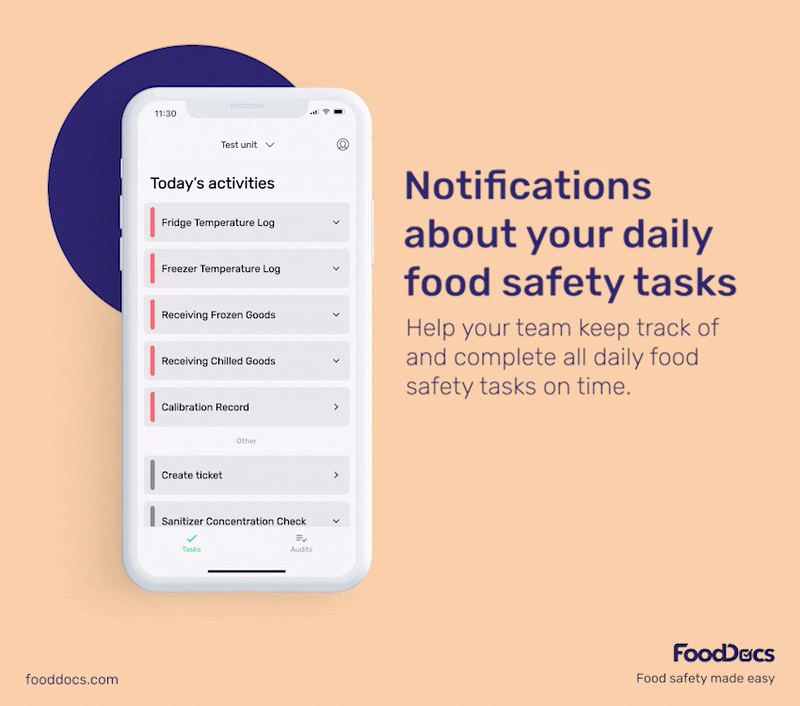
Frequently asked questions about restaurant manager responsibilities
What daily reports should restaurant managers review?
Check a daily sales report and a comps and voids summary, then compare scheduled versus actual labor and scan item mix to spot problems early. POS and ops sources highlight daily sales, labor variance, speed of service, and product mix as reports that flag waste, training gaps, or pricing issues fast.
What belongs on a restaurant manager opening checklist?
Before doors open, confirm reservations and staffing, walk the floor for cleanliness and repairs, verify equipment and cold holding temperatures, review deliveries, and set goals in pre-shift. Practical opening lists from operators emphasize communication, menu education, and basic finance tasks like bill checks or sales goals.
What belongs on a restaurant manager closing checklist?
After service, reconcile cash and POS, review discounts and voids, log sales, confirm cleaning and sanitizing, secure inventory, set thermostats and alarms, and note maintenance issues for morning follow-up. Manager-specific closing lists call out temperature checks, safe facility shutdown, and next-day prep notes.
How do you calculate labor cost percentage?
Use total labor cost divided by total sales for the period, times 100. Most sources place a typical target band around 20 to 30 percent, with variation by service model. Use that range as a benchmark and adjust by concept and daypart.
Can restaurant managers participate in tip pools?
No. The Department of Labor states managers and supervisors may not take tips from a tip pool or tip jar. Separate guidance explains how valid pools work for eligible tipped employees when an employer takes a tip credit or pays full minimum wage. Train leads on this rule and audit tip handling.
What break and minor rules should restaurant managers know?
Federal law does not require meal or rest breaks, but if short breaks are allowed they must be paid when they are about 5 to 20 minutes; bona fide 30-minute meal periods are generally not paid if the employee is fully relieved. Child labor rules also restrict hazardous tasks and hours for minors. Always layer state rules on top because many states add stricter requirements.
How should restaurant managers prepare for health inspections?
Run mock inspections against Food Code basics, verify cold and hot holding temps, tighten logs for cleaning and temperature checks, and make certifications easy to show. ServSafe and FDA Food Code resources align on documentation, temperature control, and active managerial control as inspection bedrock.
Which restaurant scheduling practices control labor and risk?
Forecast demand, staff to sales not habits, compare scheduled versus actual daily, and respect break and minor rules. Modern platforms can forecast labor to sales and surface compliance alerts so you cut overspend without violating scheduling or break laws.
What is RevPASH and why does it matter?
Revenue per available seat hour shows how well you monetize time and seating. Track RevPASH alongside table turns and spend per head to guide pacing, reservations, and menu mix decisions that raise throughput without hurting experience.
